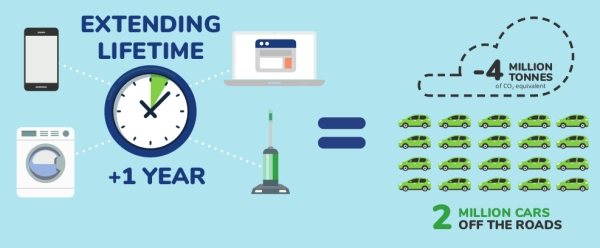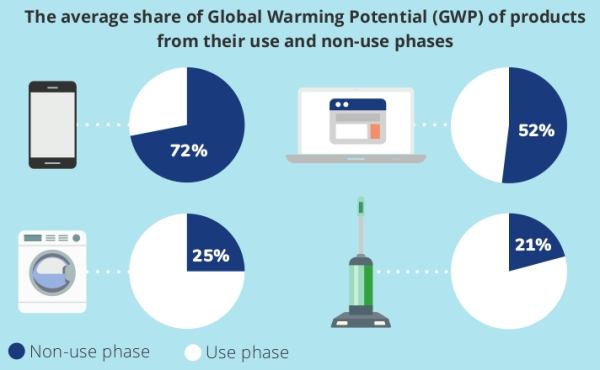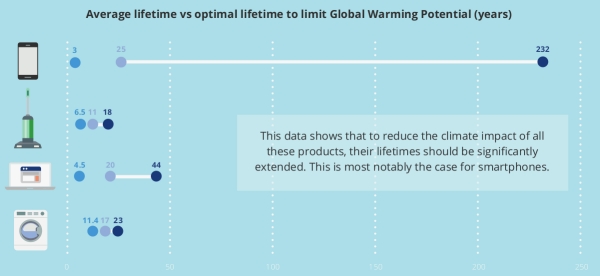The Right to Have and Repair Cool Products
And I mean cool, not “smart” products.
You may have already noticed that “Our electricals don’t last as long as they used to”. A report released in 2019 (1) measured how bad that actually is, instead of having “Cool Products that Don’t Cost The Earth”. These are the main points:
-
While it is hard to assess whether companies are purposely shortening the lifespans of electronics, the proportion of defective devices being replaced by consumers grew from 3.5% in 2004 to 8.3% in 2012.
-
Yet, there is ample evidence of consumer desire for longer-lasting products, as 77% of EU citizens would rather repair their goods than buy new ones.
-
Manufacturing products that are repairable and last longer would be really good both for the environment, and our own wallets
How good? Here is how

The study considered the energy needed to produce and distribute new products and dispose of old ones - the so-called non-use phases, distinguishing from when the product is in use or the use phase.
The analysis showed that extending the lifetime of all washing machines, notebooks, vacuum cleaners and smartphones in the EU by just one year would save around 4 million tonnes of carbon dioxide (CO2) annually by 2030, the equivalent of taking over 2 million cars off the roads for a year.
The biggest waste happens BEFORE you buy stuff
This is the worst kept, still least known secret of electronic products, especially consumer electronics that are deliberately designed to last as little as possible beyond the mandatory warrantee periods. Ignoring this reality is one of the most effective “greenwashing” tricks:
“The impact of our products in their non-use phase is often overlooked in climate assessments. For example, if emissions linked to manufacturing of imported products - i.e. most of the electricals we buy - were accounted for, the EU would not have achieved any reduction in emission since 1990."
Of course, this “energy accounting” trick doesn’t mean only more pollution. Making those “electricals we buy” in this way, that is designed to not last and manufactured hiding their true energy costs, means that everybody paid all that inefqficiency, in one way or another, from lost productivity due to public health issues to less taxes from corporations that “went green” only in appearance, or more expenses to manage non-recyclable waste.
Use the Global Warming Potential to protect your TAXPAYER rights
These days, it is possible to measure with a certain accuracy the so-called “Global Warming Potential” (GWP) of many electrical and electronic products, from mine to landfill. Literally speaking, GWP is an estimate of how much Greenhouse Gases (GhGs) are produced by both the “use phase” (actual usage) and the “non use phase” of each product, that is its manufacturing, and its final disposal. What is not explained well enough is that GWP is also a measure of how much your taxpayer rights are violated, by hiding (=making you pay anyway, sooner or later) the true costs of the “non-use phases”. This chart from the study show how much the two phases contribute to the average GWP of several classes of products:

That is a truly embarrassing chart, if there ever was one. Manufacturing a laptop or a smartphone has a greater GWP than charging and using these products over the course of their lifetime. A 72% non-use phase value in the GWP of a smartphone means that almost three quarter of the energy you consume, and of the pollution you produce, by purchasing and using it, happens before you even buy it, or after you throw it away.
Want efficiency? Repair, then. NEVER replace.
The chart above shows how and why being careful to not waste energy and money while using certain products is certainly good, but never enough. Quoting the study,
“It is often argued that energy efficiency improvements in new products justify replacing old products, because less energy use will offset the climate impact [OR, AGAIN: the money YOU waste!] linked to production. [But, even]… assuming very optimistic annual efficiency improvements of 5% across the four product groups… THIS is how longer certain products should be used, if we wanted to compensate for the greenhouse gas emissions linked to their non-use phases:"

25 years instead of 3 years for smartphones, 44 vs 4,5 for laptops, and so on... (2)
</em></u>
Executive summary:
If you care at all about polluting less OR saving all your money, from taxes to purchases:
- “in terms of GWP, it’s always better to repair than to replace one of these products”
- This does NOT means living like 2/3 centuries ago!!! Not at all!
- This is not science-fiction. It could already happen today with many products, as the Increvable washer proves
- The short report, is downloadable here, and a longer version here
- “In reality, the energy efficiency improvement of washing machines and vacuum cleaners is around 1%, as they have already become much more efficient in the recent years. For smartphones, and notebooks, new products actually tend to consume more energy than their predecessors”
(This post was drafted in April 2020, but only put online in August, because… my coronavirus reports, of course)
Who writes this, why, and how to help
I am Marco Fioretti, tech writer and aspiring polymath doing human-digital research and popularization.
I do it because YOUR civil rights and the quality of YOUR life depend every year more on how software is used AROUND you.
To this end, I have already shared more than a million words on this blog, without any paywall or user tracking, and am sharing the next million through a newsletter, also without any paywall.
The more direct support I get, the more I can continue to inform for free parents, teachers, decision makers, and everybody else who should know more stuff like this. You can support me with paid subscriptions to my newsletter, donations via PayPal (mfioretti@nexaima.net) or LiberaPay, or in any of the other ways listed here.THANKS for your support!